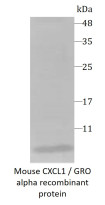ARG70435
Mouse CXCL1 / GRO alpha recombinant protein (Active) (Tag Free)
Mouse CXCL1 / GRO alpha recombinant protein (Active) (Tag Free) for SDS-PAGE
Overview
| Product Description | E. coli expressed, Active Mouse CXCL1 / GRO alpha recombinant protein |
|---|---|
| Tested Application | SDS-PAGE |
| Target Name | CXCL1 / GRO alpha |
| Species | Mouse |
| A.A. Sequence | Asn29 - Lys96 |
| Expression System | E. coli |
| Protein Full Name | Growth-regulated alpha protein |
| Activity | Active |
| Activity Note | Determined by its ability to chemoattract BaF3 cells transfected with human CXCR2. The ED50 for this effect is < 15 ng/mL. |
| Alternate Names | CXCL1; C-X-C Motif Chemokine Ligand 1; SCYB1; NAP-3; MGSA-A; GROa; GRO1; MGSA; Chemokine (C-X-C Motif) Ligand 1 (Melanoma Growth Stimulating Activity, Alpha); GRO1 Oncogene (Melanoma Growth Stimulating Activity, Alpha); Melanoma Growth Stimulating Activity, Alpha; Neutrophil-Activating Protein 3 |
Properties
| Form | Powder |
|---|---|
| Purification Note | Endotoxin level is less than 0.1 EU/µg of the protein, as determined by the LAL test. |
| Purity | > 95% (by SDS-PAGE) |
| Buffer | 50 mM Tris and 150 mM NaCl (pH 8.5) |
| Reconstitution | It is recommended to reconstitute the lyophilized protein in sterile water to a concentration not <110 μg/mL and incubate the stock solution for at least 20 min at room temperature to make sure the protein is dissolved completely. |
| Storage Instruction | For long term, lyophilized protein should be stored at -20°C or -80°C. After reconstitution, aliquot and store at -20°C or -80°C for up to one month. Storage in frost free freezers is not recommended. Avoid repeated freeze/thaw cycles. Suggest spin the vial prior to opening. |
| Note | For laboratory research only, not for drug, diagnostic or other use. |
Bioinformation
| Gene Symbol | CXCL1 |
|---|---|
| Gene Full Name | C-X-C Motif Chemokine Ligand 1 |
| Background | This antimicrobial gene encodes a member of the CXC subfamily of chemokines. The encoded protein is a secreted growth factor that signals through the G-protein coupled receptor, CXC receptor 2. This protein plays a role in inflammation and as a chemoattractant for neutrophils. Aberrant expression of this protein is associated with the growth and progression of certain tumors. A naturally occurring processed form of this protein has increased chemotactic activity. Alternate splicing results in coding and non-coding variants of this gene. A pseudogene of this gene is found on chromosome 4. |
| Function | Has chemotactic activity for neutrophils. May play a role in inflammation and exerts its effects on endothelial cells in an autocrine fashion. In vitro, the processed forms GRO-alpha(4-73), GRO-alpha(5-73) and GRO-alpha(6-73) show a 30-fold higher chemotactic activity. |
| Cellular Localization | Secreted |
| PTM | Disulfide bond |
Images (1) Click the Picture to Zoom In






